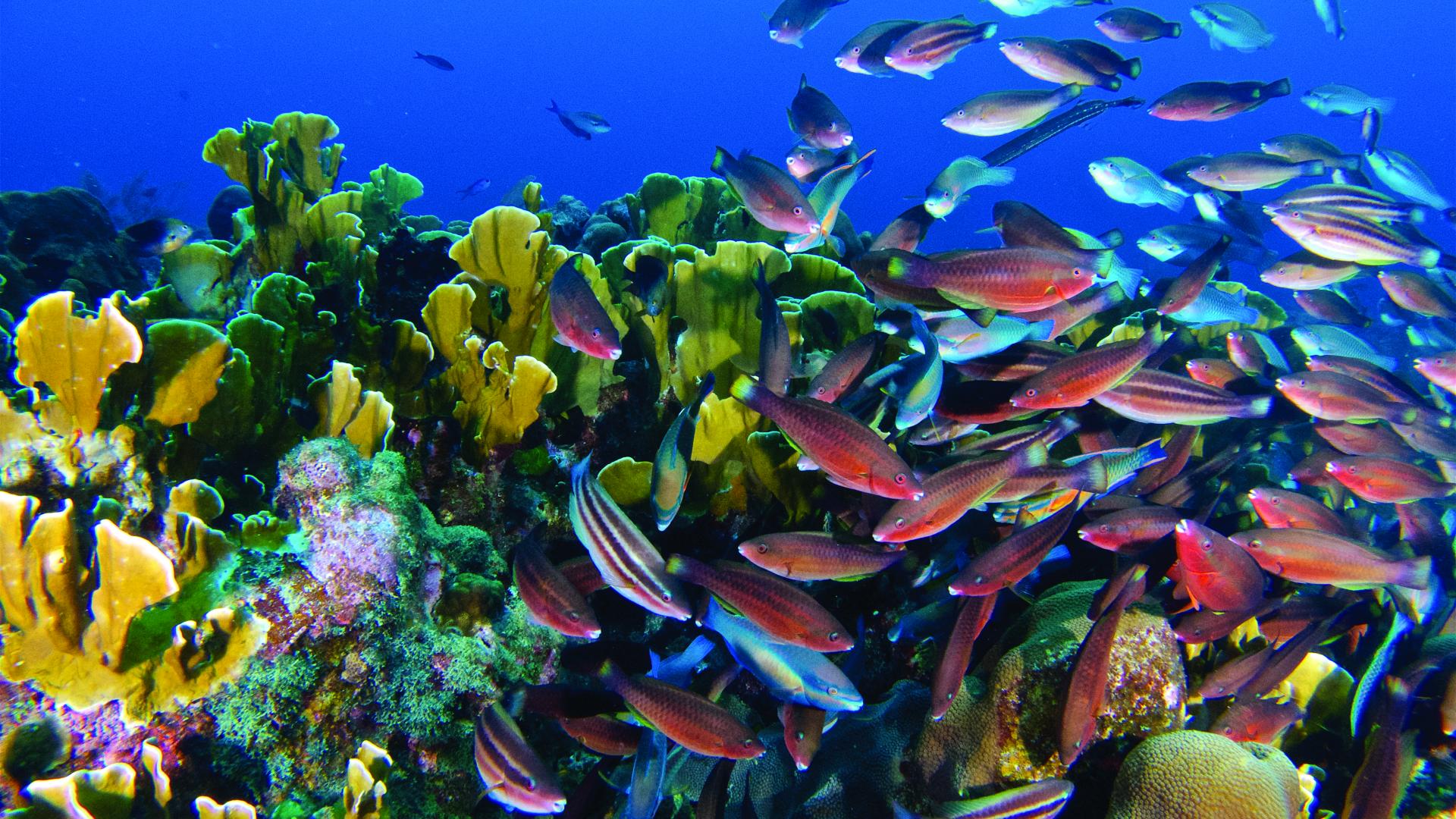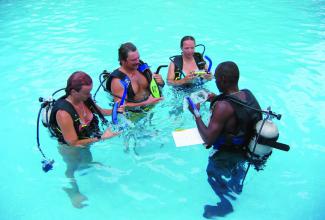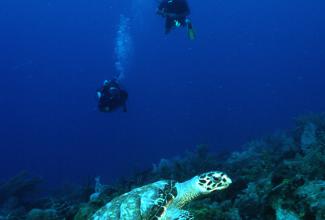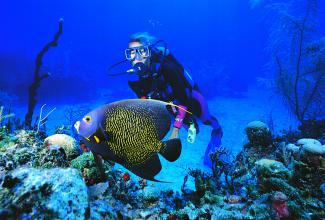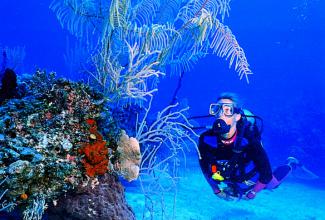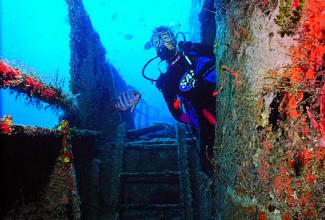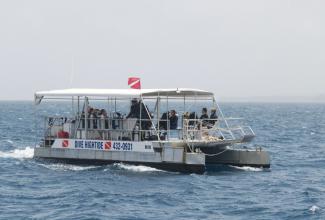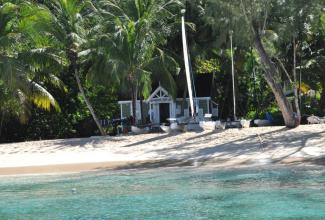In support of the 25th anniversary of Sporting Barbados magazine I have compiled 25 favourite or stand out diving or marine life related insights of Barbados. Whether you’re a scuba diver or just a holiday- maker I hope that these brief highlights will entice you to keep coming back to this beautiful island of sandy beaches, rum punches and the relaxed Caribbean heartbeat.
Barbados is blessed with a good variety of hard and soft corals, brightly coloured sponges like orange, yellow and purple, and complemented by a profusion of beautiful Caribbean reef fish and pelagic fish. With over 39 dive sites sprinkled mainly off the west and south coast barrier and fringing reefs, Barbados has plenty to offer any ability of scuba diver. Even off the beach, Barbados is a good destination to see underwater wildlife and you don’t need a fancy camera to take photos, just so long as it’s waterproof.
1. Hard to find and rare to see, seahorses are resident on various Barbados reefs. But at one particular dive site, the Cement Plant Pier located off the north/west of the island, there is a far greater chance to see one. It has been recorded that at least 10 were seen on one dive!
2. Green turtles are found all over the island and you don’t need to dive in order to see them. There are a number of snorkelling boat trips offered on the south and west coasts that will take you out to swim with these amazing creatures. Or simply go snorkelling in Paynes Bay.
3. Barbados is lucky to also have Hawksbill turtles that are a resident feature of the coastline and outer reefs. They can be found nesting onshore along the south and west coasts at night during the nesting season which is mid-June to September and the eggs hatch between mid-July to mid-October. Get in touch with the Barbados Sea Turtle Project to find out more.
4. Snorkelling or diving on the Carlisle Bay ship wrecks should not be missed. There are six wrecks of varying size and at various depths. All manner of marine life can swim by including rays and turtles and huge schools of reef fish inhabit the wrecks. Swim out from the beach or hire a local safari boat.
5. Probably the top dive site here is the wreck of the SS Stavronikita, with a length of 365 feet and lying upright in 135 feet on a sandy bottom, this mighty shipwreck provides a truly amazing array of marine life and corals both hard and soft. An underwater photographer’s dream dive. There can be strong currents here and it’s not for beginners.
6. Being part of nature conservation in action is hard to find but each week Dive Hightide Water Sports run a dive with biologists from the University of the West Indies Reef Watchers program to collect turtles. One at a time they bring them up to the boat, give them a full health check and tag them if they haven’t yet been tagged. This can take 10-15 minutes and offers an amazing opportunity to get very close to a turtle. Turtles are not harmed during the check, they breath air and can stay out of the water for up to 8 hours.
7. If we talk about diving features of Barbados we should point out where to buy equipment. Hazell’s Water World is the local stockist of all things diving and snorkelling and found on the south coast in Bridgetown.
8. Another west coast wreck but much smaller and accessible is the Pamir which plays host to established corals and reef fish schools. A great recreational dive for any level diver. Standing in 40-60 feet, she has a huge amount of resident sergeant major fish that lay blue-purple eggs on the hull. Also excellent for a night dive.
9. Sitting very close by the Pamir is a sunken yellow submarine about 20 meters away off the port bow. Lying near a coral reef there is always plenty to see.
10. Sharks Hole is the only dive site off the north coast and only available in the summer months due to rough sea conditions at other times. Sharks, usually nurse sharks, are often found taking a rest lying under a rocky ledge.
11. Church Point is a large circular reef about 100 feet in diameter with coral covered sloping edges around the outside. It’s the only circular dive site here and at 50 feet relatively shallow which means you can have a nice long leisurely dive experience.
12. Barbados has its very own Atlantis Submarine experience which runs out of west Bridgetown, and it is sometimes possible to even see it on a dive. The dive site is called Clarkes Bank and the reef offers a variety of corals and fish.
13. On the south coast Rum Barrel Reef is largely made up of beautiful soft corals called sea plumes and sea rods. Look amongst them and you will be sure to find resting turtles.
14. East coast diving is only available in the summer months when the seas are calmer. Ragged Point dive is only accessible by boat from Consett Bay. The dive is off steep rock faces with some hard corals, but teeming with fish schools such as; barracuda, chub and grunts. Rays and sharks can also be seen on this dive.
15. There are around 7 dive shops on the island that provide diving services for all abilities of divers, including PADI diver training courses. Taking a diving course is a great chance for young adults to connect with this incredible natural environment, meet local people and immerse themselves in a life changing activity. The youngest children can be 12 years old, what better way to keep them occupied!
16. Diving with Nitrox can help divers extend their bottom time and the more mature divers feel less effects of residual nitrogen, which means feeling less tired after a dive. Available from a few dive shops.
17. Night diving is a good time to see reef creatures that prefer to feed under the cover of darkness. Always carry a torch, have a buddy to dive with and keep it shallow. Wrecks are a great place to experience this and the Atlantis Submarine also offer night tours.
18. At night parrotfish try to hide so as not to be eaten by predators. To do this they find a spot to lie, usually under a rock, and secrete a mucus from their mouth to cover themselves and form a protective cocoon.
19. Barbados is probably the safest place to dive in the Caribbean because there is a hyperbaric chamber here. Situated in the Garrison, Bridgetown and serviced by a special health unit of the Barbados Defence Force. If a diver needed to re-compress after a dive accident they could do it here, it might save their life.
20. Bell Buoy is one of the few dives where you can see endangered species coral such as Elkhorn and Staghorn
coral. Both prefer shallow water, around 15-35 feet, to flourish. This makes them perceptible to being damaged by rough wave action, anchors and fishing nets.
21. Off the south coast 4-5 large pieces of the broken up wreck called Friar’s Craig lie on sand in 40-60 feet. It also lies very near to Asta Reef which is full of sea plumes, barrel sponges and the occasional seahorse. Fish schools of small mouth grunts inhabit a small cavernous part of the wreck where you can also see red gorgonian sea fans.
22. Down in the south Barbados Blue is one of the most marine conservation conscience dive shops and a PADI Project AWARE Coral Reef Monitoring Dive Centre. They offer experienced divers, with a little time, to get involved and help monitor coral nurseries.
23. High Wire is a southerly dive site covered in hard and soft corals and being an outer banking reef considered a deep dive. The gorgonian sea fans and fish life draw divers here with regular sightings
of barracuda, rainbow runners and blackjacks. It’s an outer reef so you never know what may swim past.
24. Lionfish were introduced to the Caribbean by accident a few years ago and because of their ability to mature at an early age and lay millions of eggs a year and have a ferocious appetite for
fish they now pose an enormous threat to all the reef stock throughout the region. Here on Barbados they are speared without mercy by most divers and spear fishermen. Once filleted they provide an excellent meal, in fact many restaurants on Barbados include the fish on their menus, it is delicious so give it a try!
25. If you are looking for more information and detail about the diving here there is a popular informative, photography rich ‘Barbados Dive Guide’ book available throughout the island and at most dive shops. I wrote it with an eye to showcase the beauty of the diversity of marine life that exists here. Every photographic subject is named and explained so that the reader can understand and learn about marine life and in addition, I hope, help create awareness for children.

